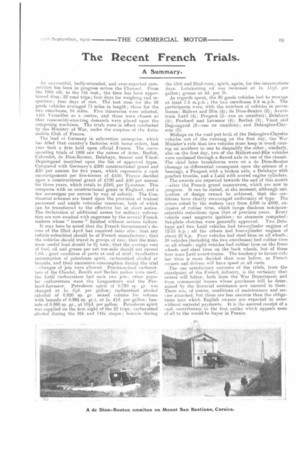The Recent French Trials.
Page 7

If you've noticed an error in this article please click here to report it so we can fix it.
A Summary.
uneventful, badly-attended, and over-reported competition has been in progress across the Channel. From the 10th ult, to the 7th inst., the time has been apportioned thus: 22 road trips; four clays for weighing and inspection; four days of rest. The test runs fel-. the 28 goods vehicles averaged 75 miles in length ; those for the two omnibuses, 94 miles. Five itineraries were selected, with Versailles as a centre, and these were chosen so that reasonably-exacting demands were placed upon the competing machines. The trials were in effect conducted by the Ministry of War, under the auspices of the Automobile Club of France.
The lead of Germany in subvention enterprise, which has filled that country's factories with home orders, last year took a firm hold upon official France. The eorreeponding trials of 1909 saw the names of Aries, lierlist, Cohendet, de Dion-Bouton, Delahaye, Saurer and VinotDeguingand inscribed upon the list of approved types. Compared with Germany's £200 constructional grant and £50 per annum for five years, which represents a cash encouragement per five-tonner of £450, France decided upon a constructional grant of £120 and £40 per annum for three years, which totals to 2240, per 21-termer. This compares with no constructional grant in England, and a few sovereigns per annum by way of subsidy. The Continental schemes are based upon the provision of trained personnel and ample vehicular resources, both of which can be transferred to the effective list at short notice. The declaration of additional names for military subvention are now awaited with eagerness by the several French makers whose " teams " finished without serious failure.
It may here be noted that the French Government's decree of the 22nd .April last required inter alia : that any vehicle submitted should be of French manufacture; that the vehicles should travel in groups of two; that the minimum useful load should be 21, tons; that the average cost of fuel, oil and grease per net ton-mile should not exceed
; good condition of parts at end of trial ; facultative consumption of petroleum spirit, earburetted alcohol or benzoic, a.n.d their successive consumption during the trial —changes of jets were allowed. Preeision-feed carburetters of the Claudel, Zenith and Berliet makes were used ; the fiatil carburetters had each two jets ; other popular earburetters were the Longuemare and the Panhard-Levaseor. Petroleum spirit of 0.720 sp gr. was charged at Is. 51d. per gallon; carburetted aleohol (alcohol of 0.820 sp. gr. mixed volume for volume with benzole of 0.884 sp. gr.), at is. 41d. per gallon ; hensole of 0.880 sp. gr., at 10Jed, per gallen. Petroleum spirit was supplied on the first eight of the 22 trips; earburetted alcohol during the 9th and 14th stages; benzole during
the 15th and 22nd runs; spirit, again, for the intermediate days. Lubricating oil was reckoned at Is. 111(1. per gallon ; grease at Id. per lb. As regards speed, the 30 goods vehicles had to average at least 7.5 m.p.h.; the two omnibuses 9.3 m.p.h. The participants were, with the numbers of vehicles in parentheses; Malicet and Thin (4); de Dion-Bouton (2); Avanttrain Lail (4); Peugeot (5—one an omnibus); Delahaye (4); Panhard and Leyassor (4); Berliet (4); Vinot and Deguingand (3—one an omnibus); and Delaugere-Clayette (2).
Mishaps on the road put both of the Delaug'bre-Clayette vehicles out of the running on the first day, the War Minister's rule that two vehicles must keep in touch causing an accident to one to disqualify the other ; similarly, also on the first day, two of the Malicet-and-Blin vehicles were unclassed through a flawed axle in one of the chassis. The chief later breakdowns were on a de Dion-B.outon (damage to differential consequent upon the seizure of a bearing), a Peugeot with a broken axle a Delahaye with • gearbox trouble, and a Laid with scored engine cylinders.
The awards are expected towards the end of this month —after the French grand manceuvres, which are now in progress. It can be stated, at the moment, although unification of design cannot be achieved, that the conditions have clearly encouraged uniformity of type. The prices asked by the makers vary from £4-00 to 000, exclusive of rubber tires, which range discloses not-incon• siderable reductions upon that of previous years. Every vehicle used magneto ignition ; no steamers competed ; flat-plate clutches were generally approved. Two Delahaye and two Latil vehicles had two-cylinder engines of 12-15 h.p. ; all the others had four-cylinder engines of about 22 h.p. Four vehicles had steel tires on all wheels ; 20 vehicles (including the two omnibuses) had rubber tires on all wheels; eight vehicles had rubber tires on the front wheels and steel tires on the back wheels, but of these four were Lea avant-trains. The tendency to favour rubber tires is more decided than ever before, as French owners and drivers will have speed at all costs.
The one satisfactory outcome of the trials, from the standpoint of the French industry; is the certainty that. orders will follow, both from the War Department and from commercial houses whose purchases will be determined by the financial assistance now assured to them. There are, of course, conditions of maintenance and service attached, hut these are less onerous than the obligations into which English owners are expected to enter without material payments. It is the assured receipt of a cash contribution to the first outlay which appeals most of all to the would-be buyer in France.
























